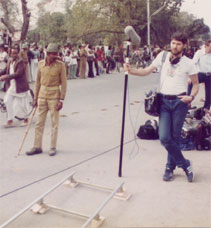 The art of better sound -
when to say "No" ...
The art of better sound -
when to say "No" ...
For some people, their experience of recording sound starts with making
wedding videos or recording other live events. As a sound recordist, you’re there to capture whatever is happening,
as best you can. Getting better sound under those conditions
usually involves better equipment, or making better use of what you’ve already
got. But not all shoots are like that, and it’s easy to fall into the trap of
thinking that’s the only way of working. What I’m saying is that whenever you
can have any control over your environment, you should try to make use of it.
Directors and cameramen don’t make things easy. Sound is rarely seen as being as
important as the pictures, and the soundman is well down the production
hierarchy, so you have to try to be assertive (but tactful). With few
exceptions, no-one else on location actually listens to sound objectively. The
human brain is remarkably good at rejecting unwanted noise when it suits us, and
locations are usually chosen on the basis of how they look, not how they sound.
Camera lenses offer 100% rejection of anything out of shot, but microphones
don't, no matter how directional. So don’t just accept shooting in a noisy location
without exploring the alternatives.
 Sometimes it’s sheer laziness. The camera gets set up somewhere for no better
reason than because it’s outside the front door or next to where the car’s
parked. The lighting’s OK and there’s a reasonable view in the background, but
there’s a busy road nearby. Now if the road is in shot and it’s the reason for
your being there, there might be some justification for staying near it, but
usually it isn’t. You can be lazy too, go with the flow, and end up with a noisy
sound track. Or you can look around for somewhere quieter, maybe behind a
building, or simply further away. With very high frequency signals like light,
which travels in straight lines, you can use a simple object like a “french
flag” to keep the sun off the front of the lens. Blocking out unwanted sound
from a microphone is not so easy. The much lower frequency of sound means that
it tends to flow around objects like a fluid, so is pretty hard to stop. The
lowest (bass) frequencies can also pass through solid objects, like partition
walls, with surprising ease, as anyone living with teenage children will
probably attest to. If
there’s nothing to act as a large solid shield to reduce the level, then
distance is the next best defence.
Sometimes it’s sheer laziness. The camera gets set up somewhere for no better
reason than because it’s outside the front door or next to where the car’s
parked. The lighting’s OK and there’s a reasonable view in the background, but
there’s a busy road nearby. Now if the road is in shot and it’s the reason for
your being there, there might be some justification for staying near it, but
usually it isn’t. You can be lazy too, go with the flow, and end up with a noisy
sound track. Or you can look around for somewhere quieter, maybe behind a
building, or simply further away. With very high frequency signals like light,
which travels in straight lines, you can use a simple object like a “french
flag” to keep the sun off the front of the lens. Blocking out unwanted sound
from a microphone is not so easy. The much lower frequency of sound means that
it tends to flow around objects like a fluid, so is pretty hard to stop. The
lowest (bass) frequencies can also pass through solid objects, like partition
walls, with surprising ease, as anyone living with teenage children will
probably attest to. If
there’s nothing to act as a large solid shield to reduce the level, then
distance is the next best defence.
Whatever you do, don’t forget the rest of the crew. Suggesting that you all walk
100 yards across a muddy field to get somewhere quieter might not go down too
well, so look for somewhere that offers a better recording environment with
minimum disruption. Bear in mind the needs of cameraman too, so that they can
still get the sort of background they want for their shot and not lose whatever
light they had because of moving location. In short, to come up with suggestions
that are going to be accepted, you have to be aware of everyone else’s
requirements because you can’t necessarily expect them to be aware of yours.
 Sometimes, nothing is going to work. For example, if you’re asked to record an
interview with a group of little kids with nervous, quiet voices against any
sort of background noise, in a wide shot, with the mic out of shot, forget it.
If it’s going to work at all it would probably need to be on a hand-held mic an
inch or two from the speaker’s mouth. Sometimes even that isn’t enough. If you
watch motor racing, you’ll have heard how interviews in front of the pits can be
completely drowned out by engine noise even when the interviewee is shouting
into a mic held right in front of him.
Sometimes, nothing is going to work. For example, if you’re asked to record an
interview with a group of little kids with nervous, quiet voices against any
sort of background noise, in a wide shot, with the mic out of shot, forget it.
If it’s going to work at all it would probably need to be on a hand-held mic an
inch or two from the speaker’s mouth. Sometimes even that isn’t enough. If you
watch motor racing, you’ll have heard how interviews in front of the pits can be
completely drowned out by engine noise even when the interviewee is shouting
into a mic held right in front of him.
Background noise isn’t the only enemy you have to deal with. The acoustics of
the environment are often just as significant. Rooms with hard walls and few
furnishings have distinct resonances and small rooms can sound particularly
“boxy”. Whilst this sort of sound can be quite desirable in creating a realistic
“small room” atmosphere if that’s the intention, usually it isn’t. Often part of
the sound track will be used with different pictures which don’t depict a “boxy”
room. When used in this way, it’s best if the sound has no discernable acoustic
traits which link it to any particular location. In post-production, you can mix
in any sort of reverb to an existing recording, but, like paint, you can’t
un-mix reverb. Voice-overs are recorded in a studio or acoustically treated
sound booth for this very reason.
 On location, you can do worse than aim for the same sort of “dry” sound as you
would get in a studio. You won’t normally get it, but there’s no harm in
aspiring to it. So don’t just accept a location with poor or inappropriate
acoustics without a fight. Go for a walk around the immediate area and see if
you can find somewhere better. Clap you hands and listen to the echoes and for
any “ringing”, which is where your clap turns into an identifiable tone as it
decays, rather than a random “shash”. The less echo of any sort, the better, but
ringing at any frequency is particularly undesirable because the sound level
will momentarily peak every time that resonant frequency is generated. If you
can’t find somewhere that sounds better, look around for objects which can give
you some control. Draw any curtains that you can do. Soft objects are best at
absorbing sound, but anything that will break up parallel surfaces can help. Set
everything that’s movable at different angles and not directly against walls in
order to break up the resonant sound reflections.
On location, you can do worse than aim for the same sort of “dry” sound as you
would get in a studio. You won’t normally get it, but there’s no harm in
aspiring to it. So don’t just accept a location with poor or inappropriate
acoustics without a fight. Go for a walk around the immediate area and see if
you can find somewhere better. Clap you hands and listen to the echoes and for
any “ringing”, which is where your clap turns into an identifiable tone as it
decays, rather than a random “shash”. The less echo of any sort, the better, but
ringing at any frequency is particularly undesirable because the sound level
will momentarily peak every time that resonant frequency is generated. If you
can’t find somewhere that sounds better, look around for objects which can give
you some control. Draw any curtains that you can do. Soft objects are best at
absorbing sound, but anything that will break up parallel surfaces can help. Set
everything that’s movable at different angles and not directly against walls in
order to break up the resonant sound reflections.
In an ideal world you only need one microphone. You simply move around until you
hear with your ears what you want to record and that’s where you position your
mic. Sometimes, you really can do this. In the great outdoors, well away from
machinery and reflective material, there is virtually no background noise or
reverberation. When people are further away, they are simply quieter. When you
turn up the gain all you get is more volume, not more background or acoustic
colouration. If you’ve never experienced it, take your sound kit on a trip to
your nearest wilderness and try it. Not only does everything sound great, but
it’s so much easier to work under those conditions. And when you’re back on a
normal shoot, remember it as a benchmark for what can be possible, the closer
you can get to recreating those conditions.
If you want to record better sound then don’t record what you know is going to
be bad sound. Just say, "No"! It’s not as hard as you may think. It’s easy to feel
when you’re asked, “Is this OK for sound?”, that you’re being asked “Are you up
to the job?”, and the natural response is to want to say "Yes". But another way to
look at it is to imagine they’re saying “Look, we haven’t actually planned this
properly and we might just be giving ourselves problems later, so are we going
about it in a sensible way?”. Usually you can say, "Yes", but even with all the kit
in the world your best answer should sometimes be "No".

" I've been a regular contributor to user groups and technical forums for the last 20 years or so, and have written hundreds of posts offering advice and information on a whole range of computer, audio & video production topics."Read some of them here... |






 Copyright ©
2022 Zen Computer Services.
Copyright ©
2022 Zen Computer Services.